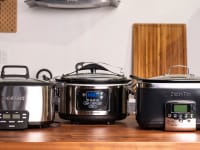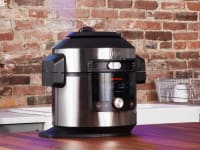Crock-Pot vs. Instant Pot: Which makes better chicken?
We put America's favorite multicooker and a classic slow cooker to the test.
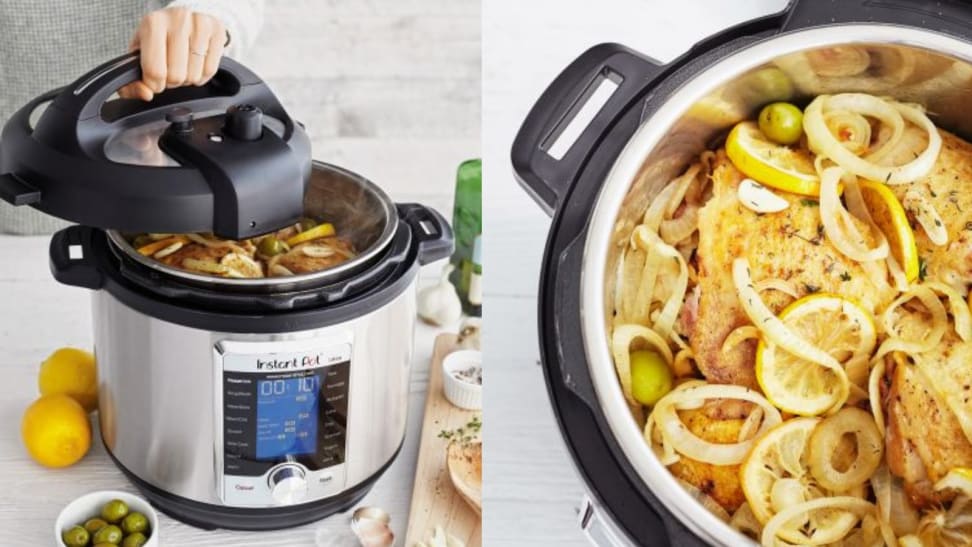 Credit:
Sur La Table
Credit:
Sur La Table
Products are chosen independently by our editors. Purchases made through our links may earn us a commission.
The Crock-Pot slow cooker has been saving American home cooks a lot of grief since the 1950s. The design is simple: Put all your ingredients in the inner pot, leave it on for several hours, and voila, you have dinner. Pressure cookers also take the stress out of cooking for a big family by rapidly reducing cook time for all types of meals.
While slow cookers and stovetop pressure cookers have both been fantastic kitchen helpers for decades, the popular Instant Pot claims to do both processes better, faster, and more safely.
After testing the best slow cookers and best pressure cookers on the market, we knew what we liked about each device. But which actually makes food taste better?
To find out, we tested two different chicken recipes—French classic coq au vin and spicy Korean pulled chicken—in an Instant Pot vs slow cooker head-to-head challenge. Here's what we learned.
Understanding temperature
Before you get to cooking, you need to understand your meat. Raw meat, and chicken in particular, has relatively little flavor. As Harold McGee’s notes in On Food and Cooking, “Cooking intensifies the taste of meat and creates its aroma. Simple physical damage to the muscle fibers causes them to release more of their fluids and therefore, more stimulating substances for the tongue.”
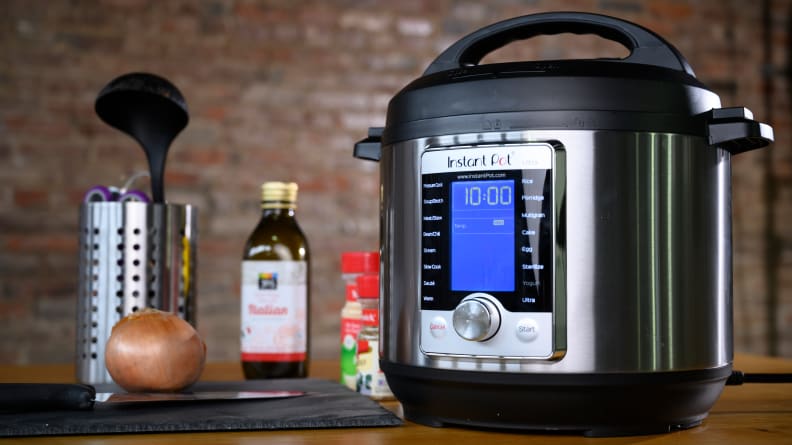
The Instant Pot Ultra can both pressure cook and slow cook.
In general, we like our chicken to be tender and juicy rather than tough and dry. Therefore, the ideal cooking method would minimize fluid loss and the toughening of fibers while converting the tough connective tissue collagen to fluid gelatin.
Although types of meat with a significant amount of connective tissue must be cooked to a minimum of 160ºF to dissolve their collagen into gelatin, muscle fibers will start to lose their juices at 140ºF, making the balance tough to strike. One solution? Slow cooking at a temperature below 200ºF, which minimizes the loss of juices from muscle fibers over time.
Slow cooking vs. pressure cooking
While conventional slow cooking is limited to a maximum temperature of boiling water, pressure cooking allows us to raise the temperature from 212ºF to 250ºF.
By tightly sealing the pot, the vaporized water can build the pressure to about double the normal air pressure at sea level. The combination of increased pressure and high temperature reduces the cooking time by a tremendous amount.
For this reason, pressure cooking is essentially the opposite of slow cooking—it cooks hot and fast, instead of low and slow.
While the right recipes can turn out wonderfully in a pressure cooker, science says that not all types of meat are up for that high pressure cooking. We tried preparing a traditionally slow-cooked chicken dish in an Instant Pot to see if it could stand the pressure.
Recipe 1: Pressure cooker coq au vin
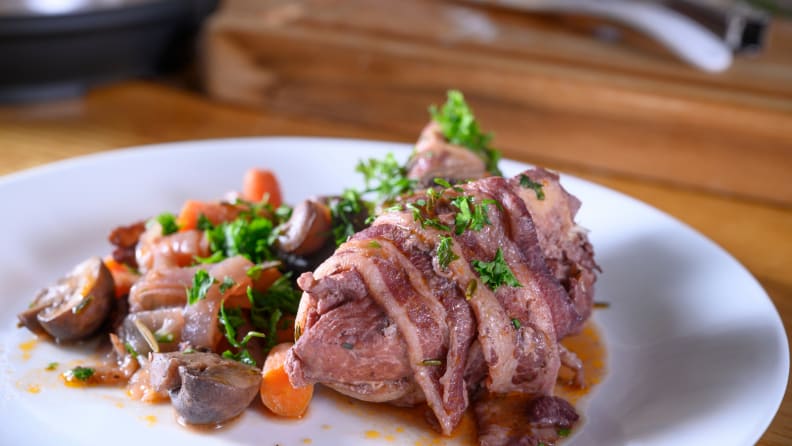
This French classic is truly a labor of love–and the Instant Pot version doesn't compare.
When it comes to slow cooking, the French classic coq au vin is king of the game. The traditional recipe requires chicken to be submerged in a pot of simmering red wine for an average of six hours.
However, this Instant Pot coq au vin that I adapted requires only 20 minutes of high-pressure cooking, so we thought we’d give it a try and see how it compares to the traditional slow-cook method.
As the recipe promised, the Instant Pot cooked the coq au vin chicken inside and out within 20 minutes. However, it also took about 15 minutes for the Instant Pot to come to pressure, resulting in a total of 35 minutes minimum prep time.
Although it would be awfully convenient to have your gourmet chicken ready in under 40 minutes, the extremely high temperature of the Instant Pot dried out the meat in a surprisingly short amount of time, with a disappointing final result.
As I cook coq au vin on a regular basis in my Dutch oven, I can promise the Instant Pot version simply doesn’t provide the smooth texture, succulent meat, and the overall depth of flavor that makes the dish famous.
You won't get identical results from an Instant Pot as you would from traditional methods, like slow cooking in a Dutch oven. However, there are ways to adapt this recipe to prevent dryness. Try reducing the pressure-cooking time to eight minutes, do a quick release, and then use a meat thermometer to check if the chicken has reached an internal 165ºF. If not, turn on "Sauté" mode until it's fully cooked.
Recipe 2: Slow cooker dakbokkeumtang (Korean spicy chicken)
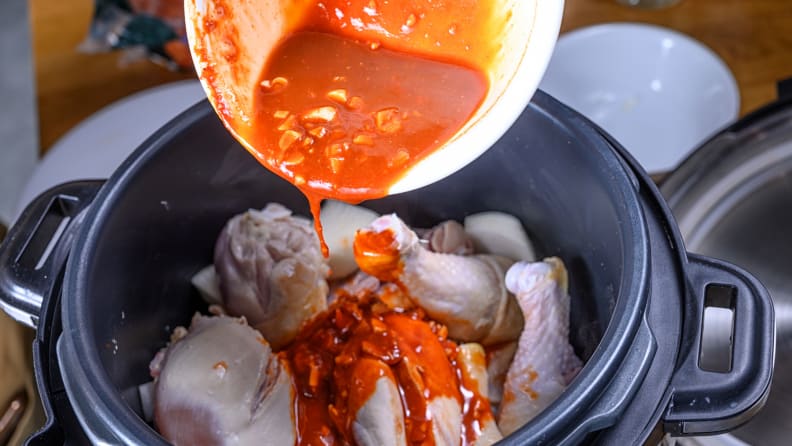
This recipe for Korean spicy chicken is very simple to make.
One of the most popular Instant Pot recipes we tend to see is for pulled chicken, which can then be used in tacos, sandwiches, and more. Why does pressure cooking work so well for this type of dish? Because the chicken pieces are coated in sauce, potential dryness doesn't really factor in.
But can Instant Pot pulled chicken be improved upon? I wrote up a recipe for slow-cooked Korean spicy chicken to see how it compares.
By operating at a much lower temperature, the Crock-Pot required about four hours of total cook time—much longer than anything we'd made in the pressure cooker. However, I was happy to get the prep work done, toss all the ingredients in, and let the Crock-Pot do its thing without requiring much monitoring from me.
Was it worth the wait? Absolutely. The slow-cooked chicken was easy to pull apart and maintained its juices and flavor. The sauce, which calls for a long list of different ingredients, was rich and full-bodied.
Although pressure cooking chicken and then pulling it is quicker than this slow-cook method, it doesn't allow the time required for the rich juices to seep in the meat.
We also chose both breasts and thighs to see how different cuts react to temperature and cooking time differences—and we were pleasantly surprised to find both types were evenly-cooked. Ultimately, slow cooking allowed our chicken to be perfectly seasoned without compromising the meat texture, a luxury pressure cooking can't afford.
The final verdict
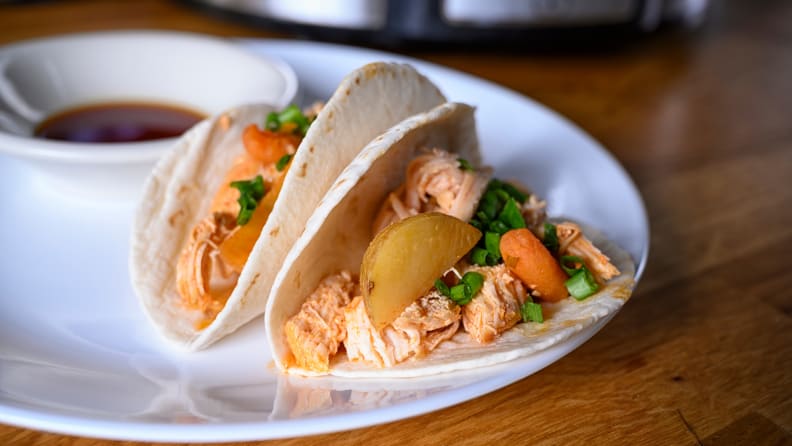
These Korean spicy chicken tacos are a great alternative to your usual pulled chicken.
So can a Crock-Pot cook better chicken than an Instant Pot? Well, it really depends on what you’re making.
The Instant Pot cooks chicken much faster than its non-pressure counterparts, but the resulting texture isn't going to be the same as what you'd get with a slow cooker or Dutch oven.
However, if you’re hosting a group of friends for pulled chicken tacos, or another dish that involves shredding and heavily coasting chicken in sauce, an Instant Pot can save you a ton of time without really compromising quality.
If you like your chicken to be tender and juicy, then Crock-Pot offers an amazing way to maintain low heat while cooking, making sure the meat soaks in all the spice and seasoning without being overcooked. It produces results similar to that of a Dutch oven, but you don’t have to worry about checking the pot regularly. This low-temperature cooking method is great for big chunks of chicken breasts or bone-in legs and thighs.
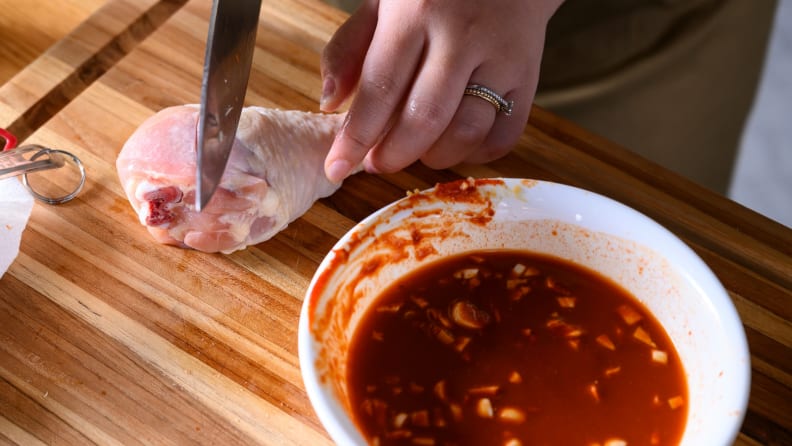
When you're cooking large pieces, lightly score them to achieve flavorful and tender results.
For those who want something versatile that tackles both slow- and pressure-cooking tasks, consider getting a multi-cooker. The Instant Pot Ultra, features a simplified dial and comprehensive display that takes the uncertainty out of cooking times, and it comes with a decently affordable price tag.
If you're committed to slow cooking, though, this inexpensive Crock-Pot slow cooker will get the job done. It produces seriously tender and tasty results with an easy-to-use, no-frills design.
One more tip: For both pressure-cooking and slow-cooking methods, try to use bone-in chicken pieces to achieve a better result. It slows the process of cooking because the bone’s honeycomb-like, hollow structure doubles as a heat insulator. That’s why meat is often tender at the bone—and why it's so delicious.

